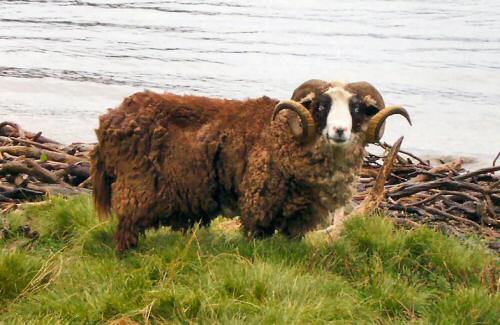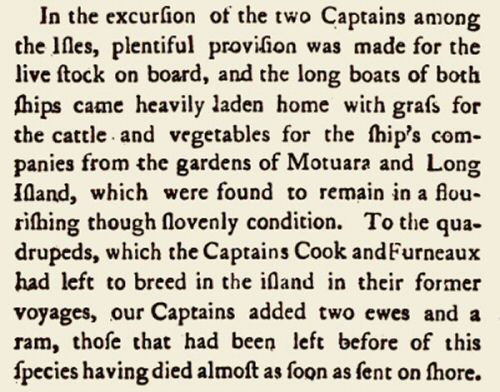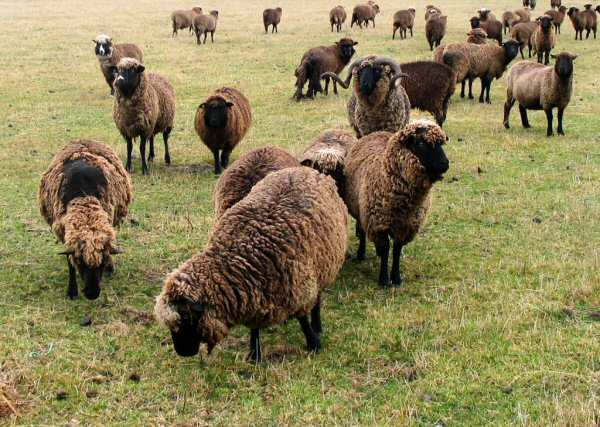Whence Came the Arapawa Sheep?
Michael Trotter

Feral Arapawa ram on the shore of East Bay, Arapawa Island
I first encountered Arapawa sheep in the wild, so to speak, when Tony Whitaker and I walked from Betty and Walter Rowe’s place in Te Aroha Bay on Arapawa Island over the hills to Hura on the east coast in 1978. Tony was making a survey of feral sheep and goats on the island, and his sheep surveys of 1975, 1978 and 1979 (see Orwin and Whitaker 1984) make a very useful comparison with those conducted by the Rare Breeds Conservation Society in recent years. I was recording archaeological sites for the Marlborough Sounds Maritime Park Board and wanted to see if there were any surface indications of early European or Maori occupation at a probable landing place on the wild east coast of Arapawa just south of where Hura is marked on the maps – we did find evidence of occupation in the form of some potatoes growing wild there and hoped that they might have been of some rare early variety, but later identification at the Botany Division of DSIR showed that they were just “ordinary”.
At that time Betty Rowe was campaigning for the protection of feral animals on Arapawa, the goats, sheep and pigs, but particularly the goats. Over dinner at the Rowe house one evening we discussed their possible origins and Betty told us of stories of ship having come into the Marlborough Sounds prior to Captain Cook’s visits.
When I checked on these I found that Marlborough historian W. J. Elvy related in his book, Kei Puta te Wairau, that there were local traditions of what was apparently a European ship coming into the Marlborough Sounds before Cook’s time – some said that the vessel was taken and destroyed, others said that it sailed away (Elvy 1957: 92). Much the same tradition had been recorded in detail from the lower North Island tribe of Ngati Hau by John White in volume 5 of his series on The Ancient History of the Maori, his Mythology and Traditions and it related specifically to Arapawa (White 1888: 120-121). The tradition referred to such things as decorated dinner plates and the ropes and sails of the ship but there was no mention of sheep.
Some years later Betty drew my attention to a book, The Spanish Discovery of New Zealand in 1576, by Ross Wiseman (1996) which provided some independent support for the pre-Cook ship stories. Wiseman gave evidence of a Spanish caravel sailing westwards across the Pacific from South America but because longitudinal measurements were inaccurate in the sixteenth century his account of it sailing into Queen Charlotte Sound as far as Waikawa (Wiseman 1996: 101–103) is somewhat speculative.
The possibility of Captain Cook having introduced the sheep onto Arapawa Island had been largely dismissed, especially after the publication between 1955 and 1967 of Beaglehole’s classic volumes of The Journals of Captain James Cook on his Voyages of Discovery. A ram and ewe that Cook put ashore in the Marlborough Sounds on 20 May 1773 had died three days later, thought to have been due to eating some poisonous plant (Beaglehole suggested that it was likely to have been tutu, Coriaria arborea). Cook remarked “… thus all my fine hopes of stocking this Country with a breed of Sheep were blasted in a moment.” (Beaglehole 1961: 167.)
A 1984 report by D. F. G. Orwin and A. H. (Tony) Whitaker (1984: 223) discussed the possible origins of the Arapawa sheep, concluding that they probably came from commercial Merinos in the nineteenth century, and this explanation became widely accepted.
Further research by Bill Secker (a foundation member of Rare Breeds), which was reported in the Rare Breeds newsletter for April 1991 in one of his series of articles on the early history of animal importations to New Zealand, did not add any new information. Bev and I accepted that the Arapawa sheep probably came from Merinos imported from Australia in the nineteenth century when we initially set up the Rare Breeds Website in 2002 (though we did mention the Spanish ship theory) and again in our book on Rare Breeds of Heritage Livestock in New Zealand in 2010.
However, new light was shed on the possible origins of the Arapawa sheep by the publication of a paper on DNA investigations in 2011 – “Arapawa: a novel New Zealand sheep breed of distinct origin” (Young et al 2011). In this and in a newspaper item (Marlborough Express 2013) it was reported that the breed’s closest relative was the Gulf Coast Native sheep found in the southern United States that were descended from the Spanish flocks brought to the New World by explorers and settlers the 1500s. The possibility that the Arapawa sheep came from a Spanish ship visiting Marlborough Sounds in the sixteenth century could not be ruled out.

Excerpt from page 55 of Rickman’s account
Intensive subsequent historical research by Alison Sutherland revealed that Cook had in fact left more sheep – a ram and two ewes – in East Bay on Arapawa Island on his third and last voyage in 1777 shortly before leaving New Zealand (Cook’s Ark by Sutherland 2019: 128). Alison had found an account by John Rickman, an officer aboard the Discovery on Cook’s third voyage, that had been published in 1781, and he reported that as well as the ram and ewe that had died when released on the 1773 expedition another ram and two ewes had been left in East Bay 1777 (Rickman 1781: 55). It is not clear where Cook got his sheep from though Alison did discuss possible sources.

Domesticated Arapawa ewes and rams in Canterbury
So it now appears that Arapawa sheep may have descended either from some left by a Spanish vessel that visited our shores in the sixteenth century or from the few that Captain Cook introduced onto the island in 1777. The latter seems more likely as Cook didn’t see any sheep already in New Zealand or hear of any being here before his visits, but either introduction makes them pretty special. They may even have come from more than one source, and it is to be hoped that their origins will be clarified by further research.
In the meantime, whatever their ancestry, the Arapawa sheep are a unique breed, and we have a responsibility to ensure that their genetics are not lost.
References
